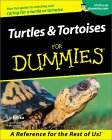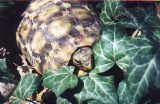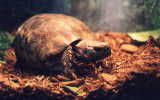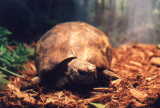African Hingeback Tortoise Central
Dedicated to the Care and Biology of Tortoises of the Genus Kinixys
Sign Guestbook
View Guestbook
 I created this page in the summer of 2001 when I had quite a bit of spare time between college and graduate school. There are plenty of errors and typos, but there is still some good information on these pages. I am no longer updating this page. To see what I am up to now, check out the Ohio Nature Blog by going here:
Buckeye State-An Ohio Nature Blog
I created this page in the summer of 2001 when I had quite a bit of spare time between college and graduate school. There are plenty of errors and typos, but there is still some good information on these pages. I am no longer updating this page. To see what I am up to now, check out the Ohio Nature Blog by going here:
Buckeye State-An Ohio Nature Blog
Species Homepages--Click for Care Information
Click Above to View Full size images of Kinixys belliana nogueyi All Images Copyright Tom Arbour 2001








These are must have books, especially the first one listed! Please check them out to help support this site.
Introduction
Hingeback tortoises, as those in the Genus Kinixys are known, are relatively small tortoises that are distributed throughout
sub-saharan Africa. Consisting of several species and subspecies, they are
offered as wild caught specimens in many pet shops. A Home's Hingeback became my first pet tortoise, but it died quickly.
After I had three hingeback tortoises die, I gave up keeping hingeback until I started college, and realized how demanding these
species can be to take care of when they are freshly imported. One of the ways I learned about the proper care of tortoises was through internet listserve's, like turtle-l.
After realizing the challenges to keeping tortoises, I now keep three bell's hingebacks. I have one
female Kinixys bellliana nogueyi, a subspecies of the Bell's Hingeback, according to Erst and Barbour (1989). I also have
two other Bell's type hingebacks that i do not know which race they belong to. Because of these differeces and variation amongst
members of this genus that I have seen, i've become especially interested in the taxonomy of this confusing genus.
I hope to develop this page to be a place to share experiences with keeping hingeback tortoises, and provide a center of
information where an owner of a new hingeback tortoise can get a good start learning about the needs of a newly imported
tortoise. I would also like to encourage and document captive breeding efforts.
Hopefully, Kinixys and all turtle and tortoise and turtle species will be banned from importation in the future. Although
Kinixys belliana are no longer imported into the United States because they carry a tick that may carry a deadly cattle disease, K. erosa and
homeana are being imported at great numbers, even though these are on ofthe most difficult tortoise species to keep. There is recent thought and discussion that these tortoises are chronically dehydrated in captivity, because they are actually semi-aquatic.
Hopefully captive breeding programs can be established to relieve the stress on wild Kinixys populations as has occurred in
other tortoise species.
General Information
"The African Hinge-back Tortoises" by David T. Kirkpatrick,
Ph.D
David Kirkpatrick has written one of the best WWW resources for the genus Kinixys. This page gives an
excellent introduction to the biology of the genus. This page is a must read for all hingeback owners.
"Hinge-Back Tortoises," by the Tortoise Trust
A page by the Tortoise Trust that outlines basic care for Kinixys belliana, K.erosa, and K. homeana.
Species Specific Information Sheets
Sign Guestbook
View Guestbook
Please, If you have any questions about my site, do not hesitate to
E-mail Me














